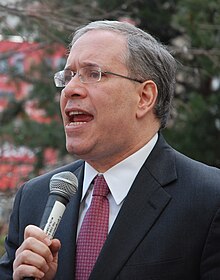Scott Stringer
In 1992, he successfully ran for a seat in the New York State Assembly vacated by Nadler, covering the Upper West Side.
Stringer served as New York State Assemblyman for 13 years and six terms, from 1992 until 2005, when he was elected the 26th borough president of Manhattan.
[7][10] His stepfather, Carlos Cuevas, was at one time the New York City clerk and a Deputy Borough President in the Bronx.
He led the fight to end empty seat voting and reform the State Assembly's rules of operation.
These reports have led the charge in addressing many of Manhattan's most important challenges and issues, including: increasing community input and response to development and planning projects across the borough; introducing comprehensive reform and empowerment measures to Manhattan's Community Boards; leading the fight to maintain[19] and create[20] new affordable housing units[21] and schools [22] across the borough; empowering[23] parents[24] to better participate in the public school system; investigating and recommending policy action on the city's many transportation issues;[25] and helping working families[26] and small businesses[27] access resources to become and remain self-sufficient.
In November 2008 and December 2009 as Borough President, he hosted day-long conferences on the subject of progressive food policy.
Working with community leaders, elected officials, local businesses, and local residents, Stringer worked to raise awareness about bike lane safety, and recommended an "increase in protected bicycle lanes, which are separated from traffic by a physical barrier and stepped-up patrol by traffic enforcement agents to ticket scofflaws, along with better signage," among other ideas.
[33] Stringer hosted many Manhattan Community Boards to discuss the potential problems associated with "fracking", such as contamination to the water supply.
[35] His Republican opponent, David Casavis, a history professor and foreign affairs writer/commentator, got 16% of the vote[36] on a platform to abolish the office.
I firmly believe that innovative thinking on issues like education and the urban environment must be joined with bedrock Democratic values on gun control and immigration if New York's interests are to be effectively represented in Washington.
[42] His campaign team included spokesperson Audrey Gelman,[43] advertising agency GMMB,[44] and pollster Mark Mellman.
[50] In the days prior to the Democratic primary, several media outlets published a piece describing Stringer's vote against legislation that stripped NAMBLA of its tax-exempt status.
[51] In 2014, Stringer criticized the health department's response to complaints about rats in New York City as "weak", because they failed in their oversight and their inability to follow their own procedures.
[52] In November 2014, Comptroller Stringer announced an initiative, on behalf of the $160 billion New York City Pension Funds, to give long-term shareholders the right to nominate their own directors at 75 U.S.
The 75 proposals were filed based on three priority issues: climate change, board diversity and excessive CEO pay.
He was endorsed by a number of progressive politicians shortly after his announcement, such as Jerry Nadler, Adriano Espaillat, Jamaal Bowman, Alessandra Biaggi, Julia Salazar, Yuh-Line Niou, Jessica Ramos, and others.
[4] On September 3, 2010, Stringer married Elyse Buxbaum, an arts administrator at the time, who is the deputy director of development at The Jewish Museum.
